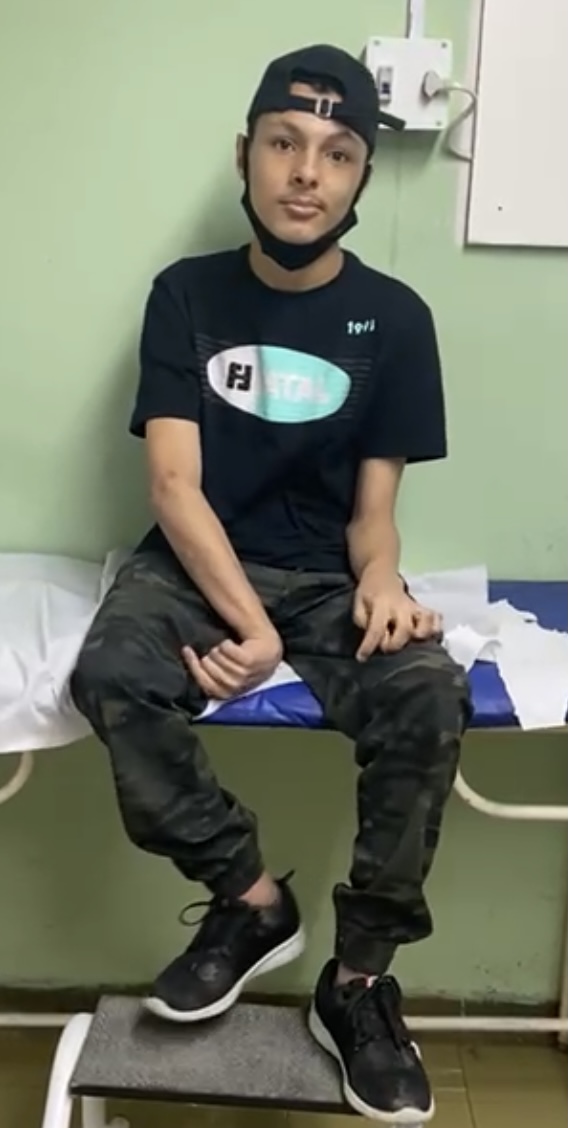Category: Genetics (Non-PD)
Objective: To describe a remarkable case of a patient with an atypical ATP1A3 phenotype with levodopa responsiveness, expanding our understanding of this gene mutation.
Background: The ATP1A3-spectrum disorders include the descriptions of rapid-onset dystonia-parkinsonism, alternating hemiplegia of childhood, and CAPOS syndrome (1). Recently, novel cases reports have described non-classical phenotypes, such as paroxysmal dystonic attacks (2). However, few cases with dopamine responses were reported in the literature.
Method: A case report of a patient with an ATP1A3 gene mutation presenting with dopa-responsive generalized dystonia, parkinsonism, chorea, and paroxysmal dystonic attacks.
Results: A seventeen-year-old male presented with transitory episodes of generalized non-painful limb stiffening, which started at seven months of age. His mother describes a symptom improvement during sleep. No clear trigger was identified. He did not have any weakness during or out of the attacks. His neurological examination showed choreiform generalized movements, asymmetric upper limb dystonia, and bilateral bradykinesia. He could walk independently, albeit with a marked worsening of hyperkinetic movements while walking. His parents were non-consanguineous. A relevant speech delay was referred, and he did not write or read yet. After the first evaluation, he was diagnosed with paroxysmal kynesigenic dyskinesia. With no improvement, different medications were tried, such as carbamazepine, valproate, phenytoin, acetazolamide, and topiramate. Afterward, a levodopa trial was initially performed with 50mg of levodopa twice daily. The patient showed a marked worsening of stiffening episodes and frequent choreic involuntary movements. A lower titration was suggested, and a substantial improvement was noticed. He displayed shorter episodes now only restricted to the legs. He had a normal electroencephalogram, as well as cardiac evaluation and laboratory exams (including serum ceruloplasmin and urinary copper). Brain MRI revealed a mild left hippocampal malrotation with no other abnormalities. An exome was requested, demonstrating a pathogenic mutation in the ATP1A3 gene (Gly947Arg).
Conclusion: Paroxysmal dystonic attacks associated with other movement disorders are increasingly described as a part of the ATP1A3-related phenotypes. This case illustrates a relevant levodopa response, broadening the therapeutic options of these complex disorders.
References: 1. Salles PA, Mata IF, Brünger T, Lal D, Fernandez HH. ATP1A3-Related Disorders: An Ever-Expanding Clinical Spectrum. Frontiers in Neurology. 2021;12(April):1–13.
2. Balint B, Stephen CD, Udani V, Sankhla CS, Barad NH, Lang AE, et al. Paroxysmal Asymmetric Dystonic Arm Posturing-A Less Recognized but Characteristic Manifestation of ATP1A3-related disease. Movement disorders clinical practice [Internet]. 2019 Apr 4;6(4):312–5. Available from: https://pubmed.ncbi.nlm.nih.gov/31061839
To cite this abstract in AMA style:
M. Soares, J. Parmera, M. Bezerra. Dopa-responsive Combined Dystonia Due to ATP1A3 Gene Variant [abstract]. Mov Disord. 2022; 37 (suppl 2). https://www.mdsabstracts.org/abstract/dopa-responsive-combined-dystonia-due-to-atp1a3-gene-variant/. Accessed March 31, 2025.« Back to 2022 International Congress
MDS Abstracts - https://www.mdsabstracts.org/abstract/dopa-responsive-combined-dystonia-due-to-atp1a3-gene-variant/

